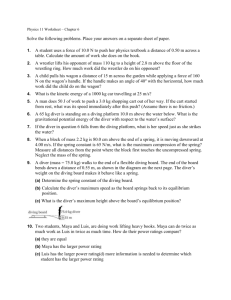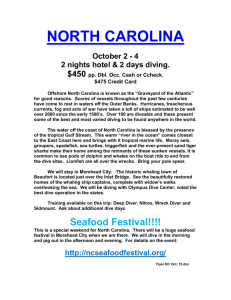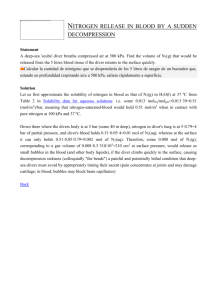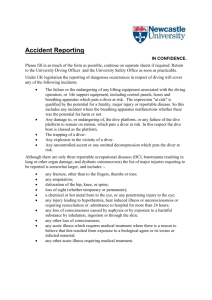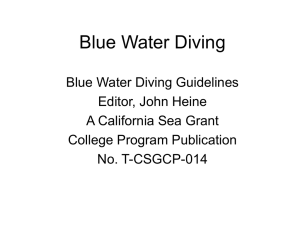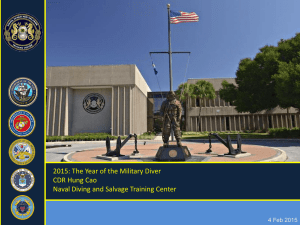unconsciousness in divers - Diving Medicine for SCUBA Divers
advertisement
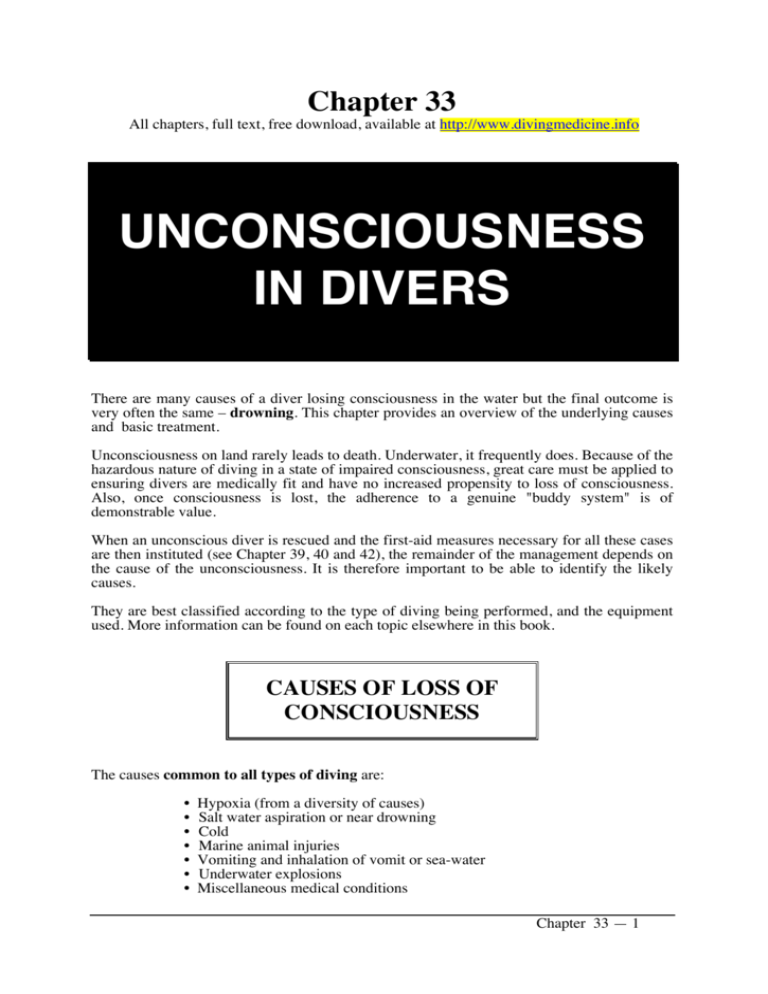
Chapter 33 All chapters, full text, free download, available at http://www.divingmedicine.info UNCONSCIOUSNESS IN DIVERS There are many causes of a diver losing consciousness in the water but the final outcome is very often the same – drowning. This chapter provides an overview of the underlying causes and basic treatment. Unconsciousness on land rarely leads to death. Underwater, it frequently does. Because of the hazardous nature of diving in a state of impaired consciousness, great care must be applied to ensuring divers are medically fit and have no increased propensity to loss of consciousness. Also, once consciousness is lost, the adherence to a genuine "buddy system" is of demonstrable value. When an unconscious diver is rescued and the first-aid measures necessary for all these cases are then instituted (see Chapter 39, 40 and 42), the remainder of the management depends on the cause of the unconsciousness. It is therefore important to be able to identify the likely causes. They are best classified according to the type of diving being performed, and the equipment used. More information can be found on each topic elsewhere in this book. CAUSES OF LOSS OF CONSCIOUSNESS The causes common to all types of diving are: • • • • • • • Hypoxia (from a diversity of causes) Salt water aspiration or near drowning Cold Marine animal injuries Vomiting and inhalation of vomit or sea-water Underwater explosions Miscellaneous medical conditions Chapter 33 — 1 In addition to these the causes associated with scuba diving are: • • • • • • Hypocapnea Decompression sickness Air embolism from pulmonary barotrauma Nitrogen narcosis Carbon monoxide toxicity Hypoxia due to faulty equipment or gas contamination In addition to these, causes associated with rebreathing or mixed gas diving equipment (not commonly used by recreational divers) include : • Hypercapnea • Oxygen toxicity • Hypoxia due to ascent, dilution or excessive consumption. The more common causes of unconsciousness are as follows: HYPOXIA (SEE CHAPTER 20) Hypoxia of the brain associated with near-drowning is the final event in many diving accidents and is the most common cause of unconsciousness in divers. It may follow events as diverse as breath-holding in free diving, inadequate air supply, salt water aspiration, equipment faults or misuse, inhalation of vomit, pulmonary barotrauma, gas contamination, etc. It is frequently associated with panic and physical exhaustion. Case History 33.1 A diver breathing from a semi-closed breathing apparatus lost consciousness shortly after leaving the surface. He was brought back to the surface and revived with 100% oxygen. His slightly bluish face turned red later on when it was discovered that he had filled his cylinders with pure nitrogen. Diagnosis: Hypoxia due to inadequate (i.e. nil) inspired oxygen. Chapter 33 — 2 HYPOXIA DURING BREATHHOLD DIVING (SEE CHAPTER 4) ! Hyperventilation. Hyperventilation before a breath-hold dive makes hypoxia more likely because the urge to breathe is suppressed. This technique was used by some divers to increase the duration of dives. The practice is gradually dying out, along with the divers who use it. ! Hypoxia of ascent. A diver can lose consciousness from hypoxia of ascent during deep breath-hold dives. The partial pressure of O2 in the lungs can fall dangerously low during ascent or immediately after surfacing. Case Report 33.2. A young diver was attempting to beat a local swimming pool underwater distance record. He was seen to hyperventilate before the dive. Midway through the second lap, he ceased to swim and sank to the bottom. Luckily, he was quickly pulled from the water and revived by mouth to mouth respiration. He was discharged some weeks later, with permanent brain damage. Case Report 33.3. An experienced diver taking part in a spear fishing competition was found dead on the bottom with a speared fish nearby. Post-mortem revealed no abnormality apart from drowning. He was known to practise hyperventilation, push himself to the limit and to dive deep. NEAR DROWNING (SEE CHAPTER 25) This is the consequence of many diving accidents. The hypoxia associated with near drowning can render a diver unconscious, or the diver can become unconscious first, and then drown. Chapter 33 — 3 COLD OR HYPOTHERMIA (SEE CHAPTERS 3, 27 AND 35) Exposure to cold water can cause an progressive and excessive fall in body temperature which can make a diver initially confused (at a body temperature of around 34°C) and then unconscious (below 30°C). A diver suddenly entering cold water can sometimes develop a hypertensive spike or cardiac rhythm disturbances which can produce immediate unconsciousness from cardiac or cerebral accidents (heart attack or stroke). MARINE ANIMAL INJURIES (SEE CHAPTER 29) Venomous animals can cause unconsciousness either from the direct effect of the venom on the brain, from hypoxia due to respiratory paralysis, or due to inadequate cerebral circulation from a lowering of blood pressure. Shock from blood loss after shark attack can also cause unconsciousness. Case History 33.4. A group of divers on their first dive on a tropical reef eagerly took to the water. They returned later with speared fish, coral and shells among which were several varieties of venomous cone shells which they had handled, and in some cases, carried under their wet suits. A member of the boat crew recognised the cone shells and advised the divers of their narrow escape. Diagnosis: potential loss of consciousness, or "accidents looking for somewhere to happen". DECOMPRESSION SICKNESS (SEE CHAPTERS 14–16) Cerebral Decompression Sickness can lead to unconsciousness. It is more likely after deep dives and repetitive diving. Chapter 33 — 4 Case Report 33.5. A 26 year old diver undertook a 55 metre (180 foot) dive with a bottom time of 8 minutes. He returned rapidly to the surface when his contents gauge indicated an almost exhausted air supply. While climbing into the boat, he complained of numbness down one side, and developed slurred speech. He then had a convulsion and lost consciousness. He died en route to a recompression chamber 600 km. away. Diagnosis: the probable diagnoses would include cerebral decompression sickness or air embolism (CAGE) from pulmonary barotrauma (burst lung). Autopsy verified the diagnosis. AIR EMBOLISM FROM PULMONARY BAROTRAUMA OF ASCENT (SEE CHAPTER 11) Cerebral arterial gas (air) embolism (CAGE) can arise either during or soon after ascent, from any depth. It can cause abrupt loss of consciousness. It is sometimes associated with pneumothorax, which needs special management. CARBON MONOXIDE TOXICITY (SEE CHAPTER 23) Divers breathing compressed air are vulnerable to this problem if the air source is contaminated, often from the exhaust of a nearby internal combustion engine. OXYGEN TOXICITY (SEE CHAPTER 21) Military divers using oxygen equipment, technical or professional divers breathing mixed gases are at risk from convulsions due to oxygen toxicity under certain circumstances. A convulsion can be followed by unconsciousness and confusion. Chapter 33 — 5 GENERAL MEDICAL CONDITIONS A variety of medical emergencies including hypoglycaemia (low blood sugar) in diabetics, heart attack, stroke, epileptic fit, drug overdose, head injury, severe infection and shock can cause unconsciousness. Many conditions with the potential to cause unconsciousness require exclusion in a diving medical examination and people with these conditions would normally be advised against diving. Case Report 33.6. A 30 year old diver using scuba at 10 metres (33 foot) became unconscious ten minutes after the start of the dive while swimming strenuously on the bottom. He was brought rapidly to the surface by his buddy. He remained unconscious on the boat and was pale and sweaty with a rapid pulse. He was breathing adequately and 100% Oxygen breathing on a mask produced no improvement. Those present were at a loss for a diagnosis until the diver's wife informed them that he was a diabetic taking insulin. He was successfully treated in hospital by intravenous glucose. Diagnosis: Hypoglycaemia (low blood sugar level) due to unexpected exertion, even though the diver took a reduced Insulin dosage. He was advised that diving and diabetes requiring medication was a suicidal combination and he agreed to take up a sport less dangerous to diabetics Chapter 33 — 6 RESCUE AND FIRST AID TREATMENT (SEE CHAPTERS 39–42) First ditch the diver's weights. The diver must be brought to the surface and then removed from the water as rapidly as possible. Emergency buoyant ascent takes precedence over concern for burst lung (pulmonary barotrauma) when the recreational diver is unconscious. These unconscious divers will usually exhale passively during ascent as the lung volume expands. After surfacing the airway must be cleared and if there is no respiration, expired air resuscitation commenced. Details of the rescue and resuscitation technique are explained in Chapters 39 and 42. After securing the essential basic life support (DRABCD - rescuing the diver from the dangerous underwater environment, verifying the state of unconsciousness by the diver’s responses, attending to the diver’s airway, breathing and circulation) the cause must be sought and specific treatment started. Diving medical advice should obviously be sought as soon as possible. Diagnosis of the cause is made by a logical process of elimination, taking into account the medical history of the diver, the equipment used, the type of diving, the dive profile, the events leading to the unconsciousness and the appearance of the diver. Assume the most serious and treatable diagnosis. Contact medical authorities (see Appendices A and B) with full details (see Check List Chapter 39) and follow their advice. Transport may be required to a medical facility or formal medevac may be instituted. Divers may be made worse by transport in certain circumstances (shark attack, decompression sickness, pulmonary barotrauma, etc.) and so this decision is best left to experienced diving physician’s cognisant with the prevailing circumstances. If aviation transport is employed, the type of aircraft and its ability to be pressurised, is also to be considered. While waiting for assistance, administer 100% O2, if needed, indicated or if in any doubt about the diagnosis. Keep detailed records and ensure that these accompany the patient. Secure and retain the equipment for future assessment. Chapter 33 — 7
